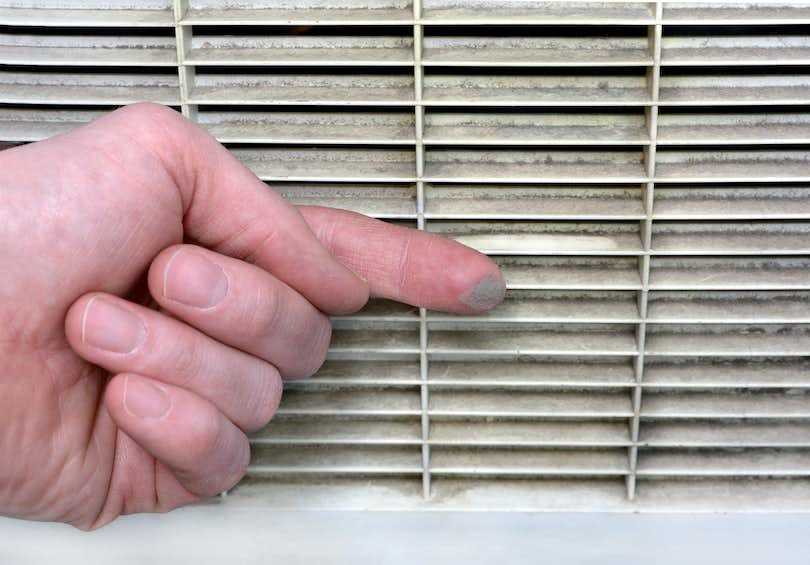Types and cost of home air quality testing | Who do I call for a professional home air quality test? | What happens during a home air quality inspection? | What makes indoor air quality bad? | Tips to improve indoor air quality

Hiring a professional to conduct a home air quality test costs an average of $420, although it can range $285-561 depending on the size of the house and the type of analysis needed.[1]
Types and cost of home air quality testing
Indoor air quality testing may be warranted in the context of a home transaction for some buyers. For example, buyers with family members who have specific allergies or sensitivities to certain contaminants may want to have their home tested before moving in.
When purchasing a new build, buyers may have concerns about the materials used and want to have the air quality checked for peace of mind. Additionally, buyers may want to have an indoor air quality inspection when purchasing an older house to ensure outdated materials like lead or asbestos are not creating dangerous conditions within the home.
A knowledgeable realtor can help you navigate the home buying process and decide whether or not a home air quality test is necessary.
>> Clever can connect you with a top-rated real estate agent today! 🏠
Home air quality inspections test for contaminants and pollutants. The price of these tests is $100-$1,000.
Contaminants are substances in the air that shouldn't be there or that are present at levels beyond what is normal. Contaminants include dust and carbon monoxide.
Pollutants are contaminants that have a negative impact on the environment and the health of the home's inhabitants. Examples of pollutants are formaldehyde and tobacco smoke.
Some of the most common air quality tests include the following.
Allergen testing: For individuals with specific allergies, these tests will identify whether or not certain substances are present within the home's air. Allergens frequently tested for include pollen, dust mites, and pet dander. The price of an allergen test is $100-200.
Asbestos testing: Asbestos testing is only necessary if structures within your home are damaged (e.g., crumbling drywall) or if you suspect a recent remodel or repair might have disturbed your home's insulation. Asbestos testing ranges $200-800, with an average price of $500.
Mold testing: Mold can seriously damage the structure of your home and is dangerous for the health of its inhabitants. If you see visible mold within your home, notice a musty odor, or experience respiratory symptoms, you may need a mold inspection. Mold testing ranges $300-1,000, with an average price of $700.
>>READ: How Much Does Mold Inspection Cost?
VOC testing: VOCs, also known as volatile organic compounds, are dangerous gasses emitted from certain liquids or solids, such as cleaning products or clothing that's been dry cleaned. Too many VOCs in the air can cause short-term health issues like nausea or long-term health issues like cancer. VOC testing averages $200-300 per sample.
Radon testing: Radon is a natural radioactive gas that is emitted from certain soils. As the second leading cause of lung cancer (after smoking), it's vital to know if your family is experiencing radon exposure. Professional radon testing costs $150-800, with an average price of $500.
Carbon monoxide testing: Carbon monoxide is a gas created in the home as a byproduct of combustion. It can come from your furnace or gas range, for example. Inhalation can cause dizziness, blurred vision, and even death. Tests range $100-200.
Who do I call for a professional home air quality test?
Indoor air quality inspectors are the most qualified to perform indoor air quality tests. There are a number of organizations that certify these inspectors, including the International Association of Certified Home Inspectors.
Many HVAC inspectors and general home inspectors are also certified as air quality inspectors and can perform air quality tests as warranted.
There are DIY air quality tests available in home improvement stores and online. These tests range $15-200. You can also purchase home air quality monitors to alert you to any potential issues for $24-2,000.
Sometimes, local health departments may offer free air quality test kits for certain pollutants such as radon.
Most of the time, DIY measures can be used to identify an air quality problem. Once you are aware of an issue, it's best to find a professional for more accurate testing and abatement advice.
What happens during a home air quality inspection?
When you hire an inspector to test your indoor air quality, they will first confirm the following home systems are intact and operating properly:
- Air ducts
- Air filters
- Exhaust fans
- Furnace
- Vents
The inspector will leverage specialized testing equipment, including sensors, meters, and spore traps to measure things like temperature, humidity, ventilation levels, and any specific contaminants they suspect are circulating within the home.
Following the inspection, samples may be sent to a lab for analysis. The inspector will provide a report on their findings and recommendations once all results are complete.
What makes indoor air quality bad?
There are numerous contaminants that can lead to poor home air quality.
Biological pollutants: Mold, pollen, dust mites, and pet dander cause allergic reactions for many. If anyone in your household has regular respiratory issues or other symptoms that seem to improve outside of the home, you may need to address one of these allergens.
Follow the EPA guidelines for mold remediation if you see or suspect mold in the home. Ensure your home is cleaned and vacuumed regularly, especially where pets congregate, to mitigate other allergens. Also, check window seals and remove shoes and outwear when entering your home to prevent outdoor allergens from coming in.
Chemical pollutants: Substances like VOCs, formaldehyde, lead, and radon are often carcinogenic and can cause other irreparable harm to human organs. Additionally, they are bad for the environment.
Try to cut back on products with toxic chemicals like certain cleaners, paint, and personal care items to eliminate these pollutants. Also, check the chemicals used to manufacture furniture, mattresses, rugs, and other new fixtures you bring into your home.
Houses built before 1978 may contain lead-based paint. Do not try to scrape or remove paint in older homes without consulting a professional. Lead dust in the air can cause major organ damage.
Radon is a naturally occurring gas that comes from certain soil types. It can cause lung cancer if it leaches into your home. The EPA has a radon zone map where you can view your county's radon risk level.
According to the EPA, almost one-third of homes have radon levels higher than they should be. Many local health departments offer free radon home test kits. If you identify high radon levels in your home, you should consult a certified radon mitigation specialist.
Combustion pollutants: We all know it's bad to smoke tobacco inside the home, but most people don't realize any combustion, including cooking, is risky without proper ventilation.
Carbon monoxide is a tasteless, odorless, poisonous gas that comes from common sources like fireplace smoke, gas generators, and running cars. Make sure you always vent a room where any type of fuel is burning. And spread carbon monoxide detectors, widely available for $15-50, throughout your home.
Tips to improve indoor air quality
To maintain good home air quality, follow a few simple recommendations:
- Have your HVAC ducts cleaned regularly
- Change air filters often
- Use air purifiers through the house
- Open windows or use vent fans when cooking and cleaning
- Choose EPA "safer choice" products
- Vacuum regularly
- Clean up after pets
- Remove mold and mildew with regular cleaning
- Follow the EPA's new construction and remodeling guidelines and check chemicals used in furniture, especially in composite wood products
Additional tips for good air quality practices in any room of the house are available via the EPA web site.
